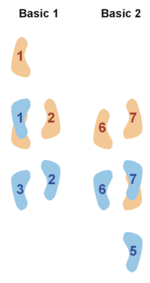
LEARN TO DANCE
(207) 671-7644
Salsa (dance)
From Wikipedia, the free encyclopediahttps://en.wikipedia.org/wiki/Salsa_(dance)
Salsa is a Latin dance associated with the music genre of the same name which was first popularized in the United States in the 1960s in New York City. Salsa is an amalgamation of Cuban dances such mambo, pachanga and rumba as well as American dances such as swing and tap.
It was primarily developed by Puerto Ricans and Cubans living in New York in the late 1960s and early 1970s. Different regions of Latin America and the United States (including countries in the Caribbean) have distinct salsa styles of their own, such as Cuban, Puerto Rican, Colombian, and New York styles. Salsa dance socials are commonly held in nightclubs, bars, ballrooms, restaurants, and outside, especially when part of an outdoor festival.
Salsa's tempo ranges from about 150 bpm (beats per minute) to around 250 bpm, although most dancing is done to music somewhere between 160 and 220 bpm. The basic Salsa dance rhythm consists of taking three steps for every four beats of music. The odd number of steps creates the syncopation inherent to salsa dancing and ensures that it takes eight beats of music to loop back to a new sequence of steps.
Los Angeles Style

Basic step for LA style, with leader's steps in blue

Salsa show dancing
Los Angeles style salsa (LA style) is danced "on 1" where dancers break forward on the first beat of the music, in contrast to New York style which is danced on 2. LA style salsa is danced in a line or "slot" with dancers exchanging positions throughout the dance, unlike Cuban salsa which is danced in a more circular fashion.
The two essential elements of this dance are the forward–backward basic step and the cross-body lead. In this pattern, the leader steps forward on 1, steps to the right on 2-3 while turning 90 degrees counter-clockwise (facing to the left), leaving the slot open. The follower then steps straight forward on 5-6 and turns on 7-8, while the leader makes another 90 degrees counter-clockwise and slightly forward, coming back into the slot. In total, the couple turned 180° with the follower and leader switching places.
The "Vazquez Brothers" (Luis Vazquez, Francisco Vazquez, and Johnny Vazquez) are credited for the early development and growth of LA Style. Luiz Vazquez was the co-founder of LA's first salsa dance team, Salsa Brava. The Vazquez Brothers drew influence from stage dances such as tap dance and helped develop LA style's reputation for flashy moves and acrobatics.
Other prominent figures in LA style salsa include salsa promoter Albert Torres, who created the LA Salsa Congress, the first salsa congress in the United States and for many years one of the largest salsa events in the world. Later dancers such as Alex Da Silva, Christian Oviedo, and Liz Lira are also credited with developing the LA style of dancing as we know it today.
Rueda de Casino
In the 1950s Salsa Rueda or more accurately Rueda de Casino was developed in Havana,Cuba. Pairs of dancers form a circle ("Rueda" in Spanish means "Wheel"), with dance moves called out by one person. Many of the moves involve rapidly swapping partners.
"Rueda de Cuba" is original type of Rueda, originating from Cuba. It is not as formal as Rueda de Miami and consists of about 30 calls. It was codified in the 1970s.
"Rueda de Miami" originated in the 1980s from Miami, is a formal style with many rules based on a mix, and is a hybridization of Rueda de Cuba & North American dance styles, with some routines reflecting American culture (e.g. Coca-Cola, Dedo, Adios) which is not found in the traditional Cuban-style Rueda.

About
The DVD Syllabus is a complete system of learning that allows dancers to progress from one skill level to the next in an organized way, In the world of dance, the key improvement is the repetition of the correct technique.
With over 10 years of continued development, the Dance Vision International Dance Association (DVIDA) Syllabus has been created by the top experts in the Dancesport industry. The DVIDA program will enhance your knowledge of steps and skill in executing them while creating the excitement of being able to progress from one skill level to the next in an organized, easy to understand system that is destined for worldwide recognition. DVIDA's mission is to provide professionals and social dancers alike with the most comprehensive , up-to-date collection of materials on the market today. The DVIDA Syllabus is recognized as one of the approved syllabi of the National Dance Council of America.
Contact
With any questions, ideas and suggestions, or to schedule an appointment please do not hesitate to call us at +1 (207) 671-7644 or to email us at aquariusnewageplayground@gmail.com
380 Western Ave
South Portland
ME 04106
Services

Testimonials

aquariusnewageplayground@gmail.com

aquariusnewageplayground@gmail.com

aquariusnewageplayground@gmail.com
